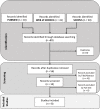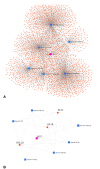MicroRNAs Targeting MYC Expression: Trace of Hope for Pancreatic Cancer Therapy. A Systematic Review
- PMID: 32308478
- PMCID: PMC7132265
- DOI: 10.2147/CMAR.S245872
MicroRNAs Targeting MYC Expression: Trace of Hope for Pancreatic Cancer Therapy. A Systematic Review
Abstract
Background: Pancreatic ductal adenocarcinoma (PDAC) is one of the deadliest malignancies and a major health problem worldwide. There were no major advances in conventional treatments in inhibiting tumor progression and increasing patient survival time. In order to suppress mechanisms responsible for tumor cell development such as those with oncogenic roles, more advanced therapeutic strategies should be sought. One of the most important oncogenes of pancreatic cancer is the MYC gene. The overexpression of MYC can activate many tumorigenic processes such as cell proliferation and pancreatic cancer cell invasion. MiRNAs are important molecules that are confirmed by targeting mRNA transcripts to regulate the expression of the MYC gene. Therefore, restoring MYC-repressing miRNAs expression tends to be an effective method of treating MYC-driven cancers.
Objective: The purpose of this study was to identify all validated microRNAs targeting C-MYC expression to inhibit PDAC progression by conducting a systematic review.
Methods: In this systematic review study, the papers published between 2000 and 2020 in major online scientific databases including PubMed, Scopus, and Web of Science were screened, following inclusion and exclusion criteria. We extracted all the experimental studies that showed miRNAs could target the expression of the MYC gene in PDAC.
Results: Eight papers were selected from a total of 89 papers. We found that six miRNAs (Let-7a, miR-145, miR-34a, miR-375, miR-494, and miR-148a) among the selected studies were validated for targeting MYC gene and three of them confirmed Let-7a as a direct MYC expression regulator in PC cells. Finally, we summarized the latest shreds of evidence of experimentally validated miRNAs targeting the MYC gene with respect to PDAC's therapeutic potential.
Conclusion: Restoring the expression of MYC-repressing miRNAs tends to be an effective way to treat MYC-driven cancers such as PDAC. Several miRNAs have been proposed to target this oncogene via bioinformatics tools, but only a few have been experimentally validated for pancreatic cancer cells and models. Further studies should be conducted to find the interaction network of miRNA-MYC to develop more successful therapeutic strategies for PC, using the synergistic effects of these miRNAs.
Keywords: MYC; cancer therapy; micro RNA; pancreatic cancer.
© 2020 Shams et al.
Conflict of interest statement
The authors report no conflicts of interest in this work.
Figures




Similar articles
-
c-Myc Represses Tumor-Suppressive microRNAs, let-7a, miR-16 and miR-29b, and Induces Cyclin D2-Mediated Cell Proliferation in Ewing's Sarcoma Cell Line.PLoS One. 2015 Sep 22;10(9):e0138560. doi: 10.1371/journal.pone.0138560. eCollection 2015. PLoS One. 2015. PMID: 26393798 Free PMC article.
-
The MYEOV-MYC association promotes oncogenic miR-17/93-5p expression in pancreatic ductal adenocarcinoma.Cell Death Dis. 2021 Dec 20;13(1):15. doi: 10.1038/s41419-021-04387-z. Cell Death Dis. 2021. PMID: 34930894 Free PMC article.
-
Tumour-suppressor microRNAs let-7 and mir-101 target the proto-oncogene MYCN and inhibit cell proliferation in MYCN-amplified neuroblastoma.Br J Cancer. 2011 Jul 12;105(2):296-303. doi: 10.1038/bjc.2011.220. Epub 2011 Jun 7. Br J Cancer. 2011. PMID: 21654684 Free PMC article.
-
Unraveling the therapeutic landscape of miRNAs in pancreatic cancer.Naunyn Schmiedebergs Arch Pharmacol. 2025 Jun 2. doi: 10.1007/s00210-025-04301-w. Online ahead of print. Naunyn Schmiedebergs Arch Pharmacol. 2025. PMID: 40455230 Review.
-
Embryonic stem cell microRNAs: defining factors in induced pluripotent (iPS) and cancer (CSC) stem cells?Curr Stem Cell Res Ther. 2009 Sep;4(3):168-77. doi: 10.2174/157488809789057400. Curr Stem Cell Res Ther. 2009. PMID: 19492978 Review.
Cited by
-
MicroRNA-125a-3p, -4530, and -92a as a Potential Circulating MicroRNA Panel for Noninvasive Pancreatic Cancer Diagnosis.Dis Markers. 2022 Oct 8;2022:8040419. doi: 10.1155/2022/8040419. eCollection 2022. Dis Markers. 2022. PMID: 36254252 Free PMC article.
-
Target c-Myc to treat pancreatic cancer.Cancer Biol Ther. 2022 Dec 31;23(1):34-50. doi: 10.1080/15384047.2021.2017223. Epub 2022 Jan 3. Cancer Biol Ther. 2022. PMID: 34978469 Free PMC article.
-
Epithelial-mesenchymal transition: a hallmark in pancreatic cancer stem cell migration, metastasis formation, and drug resistance.J Cancer Metastasis Treat. 2020;6:36. doi: 10.20517/2394-4722.2020.55. Epub 2020 Sep 27. J Cancer Metastasis Treat. 2020. PMID: 34841087 Free PMC article.
-
The Role of Non-Coding RNAs in MYC-Mediated Metabolic Regulation: Feedback Loops and Interactions.Noncoding RNA. 2025 Mar 18;11(2):27. doi: 10.3390/ncrna11020027. Noncoding RNA. 2025. PMID: 40126351 Free PMC article. Review.
-
The effect of microRNA-145 on proliferation and apoptosis of cutaneous squamous cell carcinoma cells.Discov Oncol. 2025 Jul 1;16(1):1201. doi: 10.1007/s12672-025-03032-x. Discov Oncol. 2025. PMID: 40591050 Free PMC article.
References
-
- Miller KD, Goding Sauer A, Ortiz AP, et al. Cancer statistics for hispanics/latinos, 2018. CA. 2018;68(6):425–445. - PubMed
-
- Kindler HL. A glimmer of hope for pancreatic cancer. N Engl J Med 2018;379(25):2463–2464. - PubMed
-
- Schleger C, Verbeke C, Hildenbrand R, Zentgraf H, Bleyl U. c-MYC activation in primary and metastatic ductal adenocarcinoma of the pancreas: incidence, mechanisms, and clinical significance. Mod Pathol. 2002;15(4):462. - PubMed
Publication types
LinkOut - more resources
Full Text Sources

